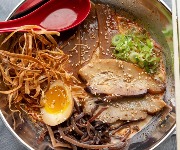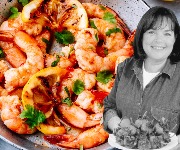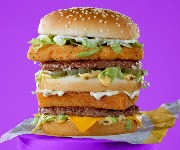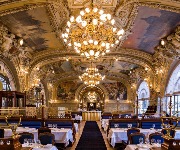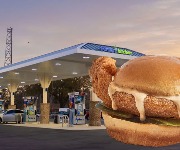Cocktail Chemistry
The bar is in full swing, and floating rounds of cocktails permeate the garden outside, until the air is alive with chatter and laughter - The Great Gatsby, 1925
There can't be many things about which one can say they enjoy short, long, bitter or sweet, still or sparkling, alcoholic, virgin, fruity or fruitless, creamy and frothy, pink, white, spent, or even on fire. Wait, there's more. We also like it red, stirred, black, maybe shaken, muddled, strained and layered, too. Actually, even if I were to bust a gut attempting to list each and every single disguise and masquerade under which it has been known to appear, I'd still fall short. For how can we ever really pin down the true identity of the chameleon King of our booze cabinets - the much-loved Cocktail?
Even those abstemious among us, who shy away from the social activity of 'meeting a friend for a cocktail', have probably unknowingly had one anyway. Why? Well, the official description of a cocktail is any drink which contains more than one ingredient - (this simple explanation is the reason the 'c' word has become the perfect epithet for lots of common phrases, e.g., Molotov cocktail, a cocktail of drugs)
To the rest of us though, it means a whole lot more. For it is quite simply the drink that embodies everything delicious about the chemical alchemy that occurs in the mixing of various ingredients. Who knew, for example, that Pomegranate Syrup marries so perfectly with dashes of ginger ale and lemon juice to make a Shirley Temple? And that Tequila and Cointreau, far from being tipples to be enjoyed alone, would together be responsible for the ebullient Margarita?
Cocktail-mixing, however, is no simple task. It is probably quite an insult to suggest as much, for any expert barista will rightfully tell you that what they do is nothing short of an art. (In hindsight, Tom Cruise did take quite a few early scenes to get his bottle-swivelling just right in that most cheesy of 1980s films, Cocktail). But their art stretches far beyond having an omniscient knowledge of ingredient coherency, since cocktail-drinking is as much as about taste as presentation, too.
To understand this element, we think of our American ancestors in the Twenties, those social butterflies haplessly trapped within the alcoholic confines of the Prohibition years. Of course, restrictions did little to hamper their palette for booze and to this day, we remember and often try to imitate their peerless high-spirited hedonistic irreverence. But in their redefining of the term 'raucous', they relied heavily upon their centrepiece - the cocktail. It was here the drink first enjoyed its widespread emergence, because for as long as illegal bootlegging was to take place, cocktails, the products of carefree mixing of expensive, illegal alcohol, epitomised the grand wealth of the age.
In these days when hems got shorter and Edwardian brooches were discarded in favour of pearls, so the fascinating neon-coloured drinks and Coupette glasses shone through as new beacons in an age of renewal. As much as it was important to be seen at social events, it soon became much more crucial to be seen imbibing the most colourful, exotic and alien drink.
Thankfully, while the hip-shaking days of the Jazz age may have long perished into history, its traditions have not. For if the cocktail was making large strides then, it most certainly is at its most developed in our current age. One need only look at menus to see how much the plethora of cocktail choice almost overruns into all other sections. Our insatiable appetite for them is such that now, along with the peppering of public houses along our well-known high-streets, there are plenty of cocktail bars, too.
But it is really our modern-day professionals who keep our enjoyment at an all-time high. At Duke's Hotel in London, the bubbly Italian Alessandro Palazzi is one of the last remaining great connoisseurs of old-fashioned cocktail mixing, and as a guest at this establishment, which is in many ways a throw back to a London of yesteryear, he is the silver-haired ball of effervescence who always ensures a sumptuous vermouth-licked Martini. It would be a travesty to order anything else, of course, for not only will Palazzi concoct your cocktail on his trolley at your table, Duke's is also the location where Ian Fleming – the James Bond creator - was to become so entranced by the in-house Martini, that it was there he coined that now eponymous phrase, 'Martini, shaken, not stirred.'
Master mixologist, the award-winning Nick Strangeway, currently bewitching customers at chef Mark Hix's locale, Mark’s Bar, is also not someone to miss. His extravagant work is second to none. In fact, an afternoon at the mercy of his scientific talents, will leave you wishing the human body were fit to imbibe little else than his rainbow-arrayed mouth-watering tipples.
But then perhaps we could? For as long as the barman went easy on the usage of eye-watering, powerful spirits, I think I would be content in having a cocktail – in whatever strength, colour, shape it comes – every single day. After all, I’ve always believed that drinking a cocktail, is akin to the unwrapping of a new present. The real treat is in the surprise.
I like to have a Martini. Two at the very most. After three I'm under the table. Four I'm under the host - Dorothy Parker
Most Recent
Comments
Be the first to comment
Do you want to comment on this article? You need to be signed in for this feature
